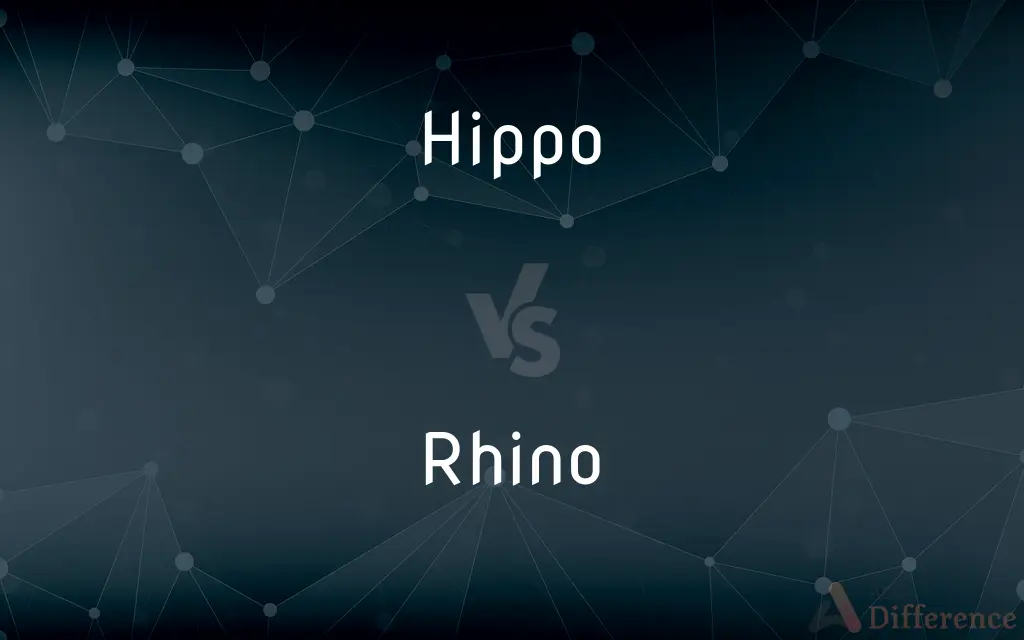Hippo vs. Rhino — What's the Difference?
By Tayyaba Rehman — Updated on October 3, 2023
Hippo is a large, mostly aquatic mammal known for its large mouth and tusks, while a rhino is recognized for its thick skin and one or two horns on its snout.

Difference Between Hippo and Rhino
Table of Contents
ADVERTISEMENT
Key Differences
Hippo, scientifically termed Hippopotamus amphibius, showcases an affinity towards water bodies, often spending a significant amount of time submerged to keep cool and protect its sensitive skin from the sun. On the flip side, the rhino, under the family Rhinocerotidae, presents a robust, tank-like appearance, predominantly terrestrial, and has a distinctively prominent horn or horns situated on its snout, which starkly contrasts the smooth, largely hornless snout of the hippo.
Diving into the diet, a hippo characteristically adheres to a herbivorous diet, consuming primarily grasses and occasionally indulging in available fruits and vegetation. Conversely, rhinos, depending on the species, can exhibit a range of dietary preferences from strictly herbivorous, munching on grasses or foliage, to being browsers, selectively consuming leaves, branches, and shrubs, highlighting a more varied dietary repertoire compared to the hippo.
Considering habitat, the hippo predominantly selects habitats closely linked with water bodies such as rivers and lakes, symbolizing their semi-aquatic nature and dependency on water for skin care and thermoregulation. Conversely, rhinos traverse across a spectrum of terrains from savannahs, forests, to grasslands, and wetlands, demonstrating a more terrestrial and varied habitat preference compared to the water-bound hippo.
Addressing size and physicality, a hippo exhibits a hefty, barrel-shaped body, short legs, and a colossal mouth, features that aptly equip it for a life partially submerged in water. On the contrary, rhinos propound a large, hulking body with a more elongated and robustly built frame, providing them with a physically imposing stature which, juxtaposed with the somewhat stubbier form of the hippo, accentuates the rhino’s terrestrial domination.
Reflecting upon conservation, both the hippo and rhino find themselves entwined in conservation concerns, albeit for divergent reasons. The hippo, while experiencing threats, largely finds its populations in a less dire situation than several rhino species, which are teetering dangerously towards extinction, impelled by relentless poaching, primarily for their iconic horns, revealing a stark contrast in the urgency and nature of conservation efforts necessary for hippos and rhinos.
ADVERTISEMENT
Comparison Chart
Habitat
Primarily semi-aquatic, near rivers and lakes
Varied: savannahs, forests, grasslands
Physical Features
Large mouth, mostly no horns
One or two horns on the snout
Size and Weight
Up to 3,200 kg and 5.2 meters long
Up to 2,300 kg (white rhino can be up to 2,300 kg) and 3.7-4 meters long
Diet
Primarily herbivorous, mainly grasses
Herbivorous, diet varies by species
Conservation
Vulnerable with population declines
Some species critically endangered due to poaching
Compare with Definitions
Hippo
A semi-aquatic mammal known for its large mouth.
The hippo yawned, revealing its enormous mouth.
Rhino
Can be identified by species, differing in size and horn number.
The Indian rhino, with its single horn, bathed in the wetland waters.
Hippo
Recognized for its barrel-shaped body and short legs.
The hippo waded into the water, its short legs navigating the muddy bottom.
Rhino
Inhabits various terrains across Africa and Asia.
The rhino ambled across the African savannah, a typical habitat for it.
Hippo
Native to sub-Saharan Africa, dwelling near water.
The hippo spends much of its day submerged in water.
Rhino
Generally solitary and known for its poor eyesight.
Despite its poor eyesight, the rhino sensed the nearby threat.
Hippo
A social animal, often found in groups termed pods.
The pod of hippos basked together along the riverbank.
Rhino
A large mammal distinguished by its nose horn.
The rhino charged, its horn pointed menacingly forward.
Hippo
Primarily a nocturnal herbivore consuming grass.
The hippo emerged at dusk to graze on the nearby grasses.
Rhino
Notoriously targeted by poachers for its horn.
The rhino, sadly, fell victim to illegal poaching activities.
Hippo
A hippopotamus.
Rhino
A rhinoceros.
Hippo
Clipping of hippopotamus
Rhino
A rhinoceros.
Hippo
Same as hippopotamus.
Rhino
(colloquial) A rhinoceros.
Hippo
An ancient Numidian town in northwestern Africa adjoining present-day Annaba in northeastern Algeria
Rhino
Gold and silver, or money.
As long as the rhino lasted.
Hippo
Massive thick-skinned herbivorous animal living in or around rivers of tropical Africa
Rhino
Massive powerful herbivorous odd-toed ungulate of southeast Asia and Africa having very thick skin and one or two horns on the snout
Common Curiosities
Where can rhinos typically be found?
Rhinos inhabit various terrains across Africa and Asia.
Do hippos live in groups?
Yes, hippos often live in groups called pods.
What is a notable physical feature of the hippo?
A hippo is known for its large mouth and tusks.
Why are rhinos often poached?
Rhinos are poached mainly for their horns.
What is a notable dietary habit of the rhino?
Rhinos are herbivorous, but their diet can vary by species.
What region is native to the hippo?
Hippos are native to sub-Saharan Africa.
How does the hippo sustain its large size?
Hippos maintain their size primarily through grazing on grasses.
What distinguishes different rhino species physically?
Rhino species vary in size, skin folds, and the number and size of horns.
How does the physical size of a hippo and rhino compare?
Hippos and rhinos are both large but vary in form and weight.
Is the hippo primarily terrestrial or aquatic?
Hippos are semi-aquatic and spend a lot of time in water.
Are all rhino species in the same conservation status?
No, conservation status varies among rhino species.
How does the hippo manage thermoregulation effectively?
Hippos manage thermoregulation by submerging in water and secreting a natural sunscreen.
Can hippos swim proficiently considering their size?
Hippos cannot swim well but move gracefully in water due to their buoyancy.
What threat does the rhino face concerning its population?
Rhinos face threats from poaching, habitat loss, and climate change.
Share Your Discovery

Previous Comparison
Scared vs. Scard
Next Comparison
Farm vs. FirmAuthor Spotlight
Written by
Tayyaba RehmanTayyaba Rehman is a distinguished writer, currently serving as a primary contributor to askdifference.com. As a researcher in semantics and etymology, Tayyaba's passion for the complexity of languages and their distinctions has found a perfect home on the platform. Tayyaba delves into the intricacies of language, distinguishing between commonly confused words and phrases, thereby providing clarity for readers worldwide.














































